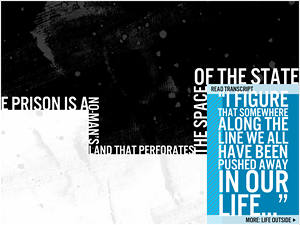


Public Secrets takes us inside the massive prison-industrial complex in central California, not as tourists but as witnesses, following Sharon Daniel as she herself witnesses the testimonies of women incarcerated in the Central California Women's Facility. These women narrate their experiences inside the prison while also giving an account of the structural conditions that reduced them to bare life, life that is without political value, life that is exposed to death. Daniel's critical commentary and theoretical reflections frame these testimonies, granting each its singularity while also articulating the systemic (il)logic of incarceration.
Author description: The expansion of the prison system is possible because it is a public secret - a secret kept in an unacknowledged but public agreement not to know what imprisonment really means to individuals and their communities. As the number of prisons increases, so does the level of secrecy about what goes on inside them. The secret of the abuses perpetrated by the Criminal Justice System and Prison Industrial Complex can be heard in many stories told by many narrators, but only when they are allowed to speak. After a series of news stories and lawsuits documenting egregious mistreatment of prisoners in 1993, the California Department of Corrections imposed a media ban on all of its facilities. This ongoing ban prohibits journalists from face-to-face interviews, eliminates prisoners' right to confidential correspondence with media representatives, and bars the use of cameras, recording devices, and writing instruments in interviews with media representatives. Women incarcerated in California are allowed visits only from family members and legal representatives. Inmates are not allowed access to computers, cameras, tape recorders or media equipment of any kind. Such restrictions preserve the public secret. For the past three years, I have visited the Central California Women's Facility [CCWF] as a legal advocate. I work with a non-profit, human rights organization, Justice Now (http://jnow.org/). Together we have been documenting conversations with women prisoners at CCWF, the largest female correctional facility in the United States in an effort to unmask the well known, yet still secret injustices that result from our society's reliance on prisons to solve social problems. Given the ban on conversations with the media, I would not have had access to the women who have contributed to Public Secrets without the support of Justice Now. As a "legal advocate" I am allowed to record my conversations with the women and solicit their stories, ideas, and opinions.
Instructions: As you browse through the piece, you will be presented with statements made by incarcerated women and others. By clicking the statement you can listen to it or read its transcript.
Previous publication: Public Secrets has been published in Vectors: Journal of Culture and Technology in a Dynamic Vernacular, Volume 2, Issue 2 (Winter 2007).
Creative Commons Attribution-NonCommercial-NoDerivs 2.5 License.

The Electronic Literature Lab could not preserve this Flash work with Ruffle in February 2021. We do plan to preserve it with Conifer at a later date.